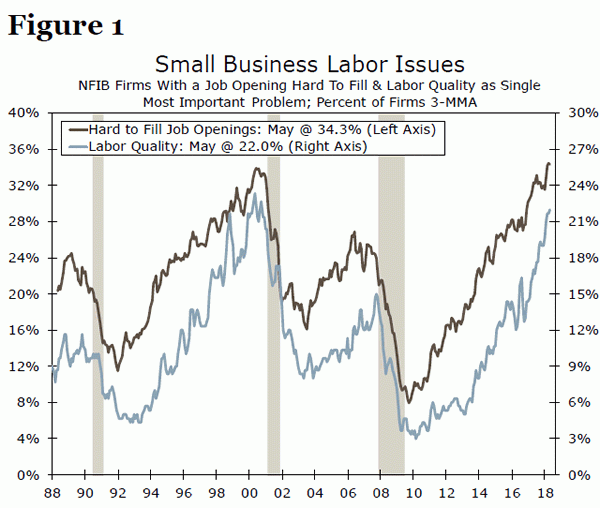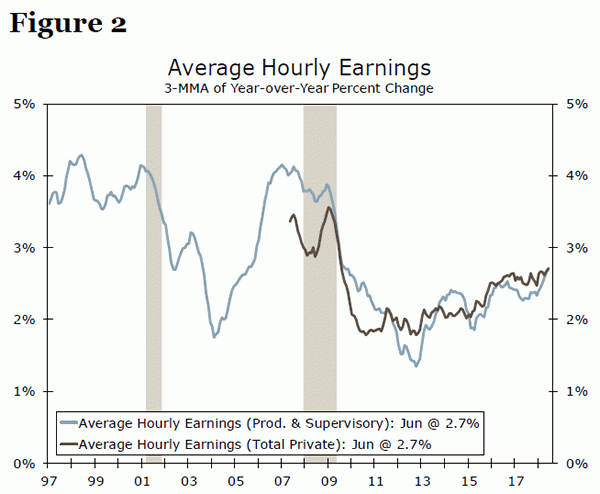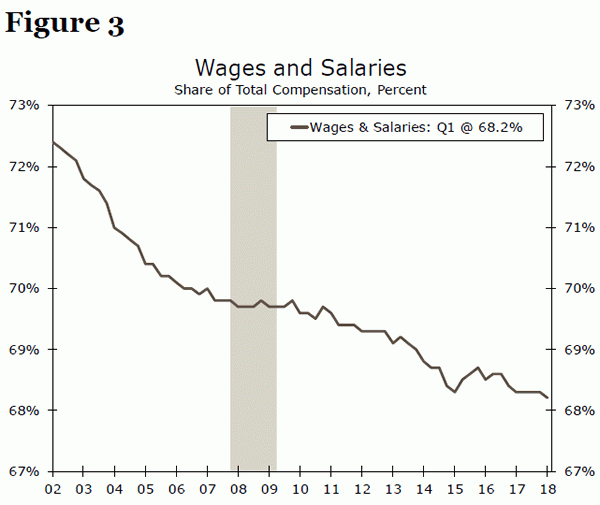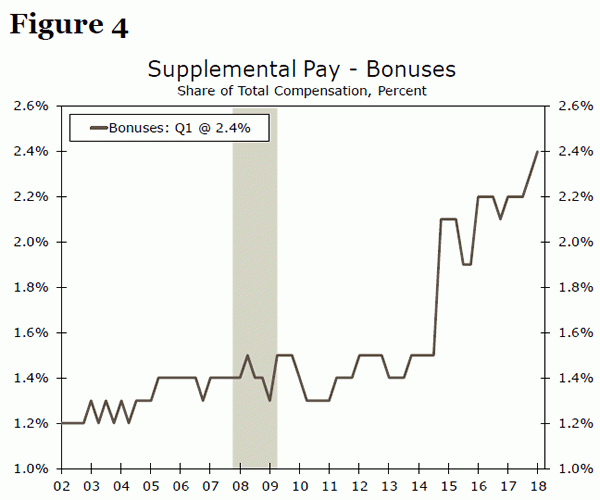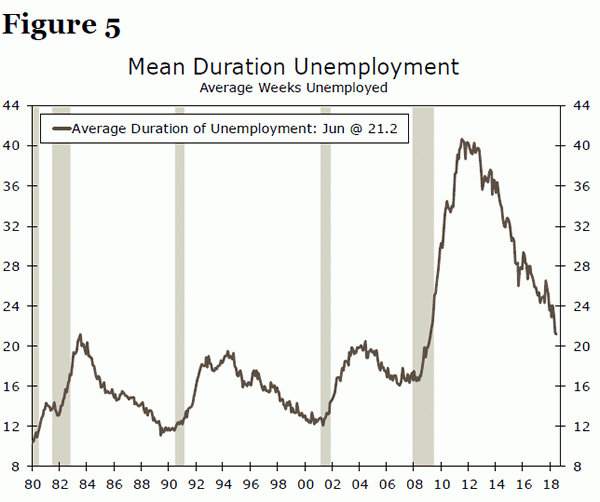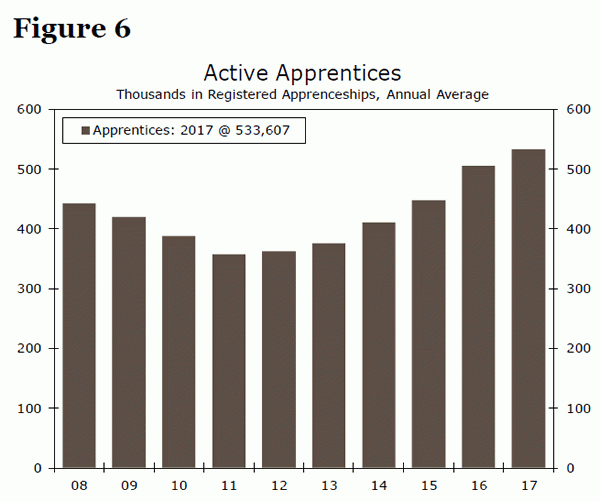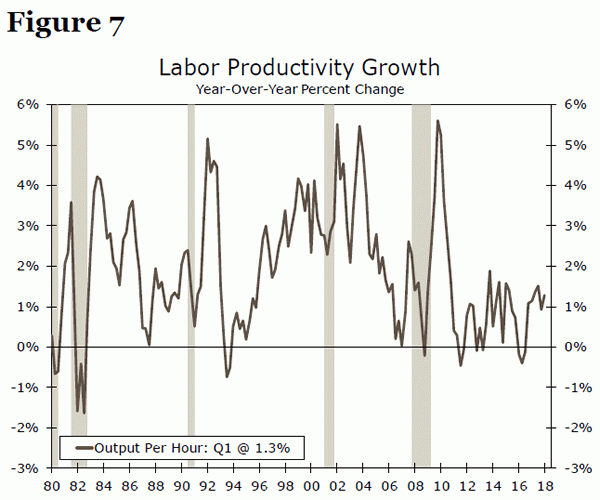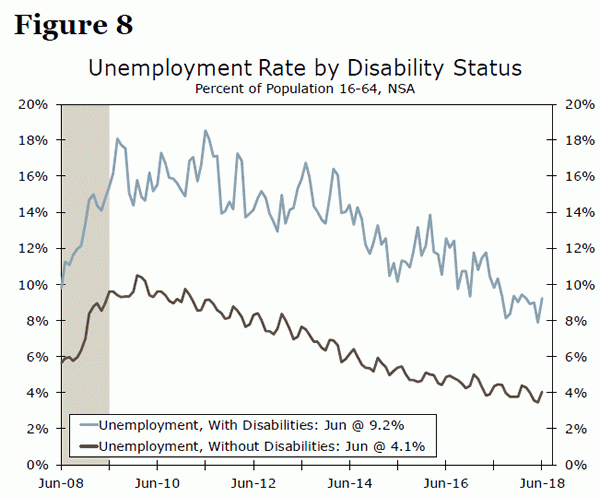How Employers Are Addressing Hiring Difficulties
Stubbornly slow wage growth has been one of the most lamented aspects of the current expansion. The historically weak pace of wage gains comes despite a tight labor market, as indicated by most employment measures. Conventional economic theory suggests that employers should be raising pay to attract increasingly scarce labor.
Employers, however, appear reluctant to commit to higher wages and salaries, which account for the largest share of employee compensation and are notoriously difficult to cut. Instead, businesses are sweetening the deal for workers around the edges. Benefits, especially one-time bonuses, are outstripping wages, while more employers are offering access to perks such as paid leave and wellness programs.
Rather than competing for already-qualified workers, employers are also “down-skilling.” By easing job requirements, employers have held the line on wages, but are increasingly shelling out for training. Those labor-related costs do not show up as earnings, but provide workers with skills that will support future wages. In this report, we explore how employers’ emphasis on benefits and their hiring of more marginal workers are contributing to tepid wage growth, even as the chorus of complaints about labor availability grows louder.
Why Aren’t Wages Strengthening More?
By most measures, the labor market is tight.1 Currently, there is less than one unemployed person per job opening. The unemployment rate fell to 3.8 percent in May, matching its lowest point since 1969, though it ticked up slightly to 4.0 percent in June. Against this backdrop, employers are increasingly voicing difficulty in finding and retaining workers. The share of small businesses reporting they have at least one job that is hard to fill hovers near the high-water mark of the 1991-2001 expansion, while small businesses most frequently cite labor quality as their number one problem (Figure 1).
Despite the ubiquitous concerns about finding workers, wage growth remains historically weak. Average hourly earnings growth has picked up since the early years of the expansion, but has yet to breach 3 percent (Figure 2). In previous work, we have highlighted some fundamental and technical factors holding down wage growth this cycle.2 Slow productivity growth over the past decade has made it difficult for companies to raise real wages rapidly, while low inflation means workers have less need to push for higher nominal wages. In addition, composition shifts in the types of jobs being added to the economy and the age of workers are holding down average hourly wages.
Yet, given the seemingly tight state of the labor market, the lack of cyclical pressures on wage growth continues to surprise many. Conventional economic theory tells us that labor scarcity leads to higher wages, and once the labor market has surpassed “full employment,” wage growth accelerates. Moreover, many businesses touted the cut to corporate tax rates from the Tax Cuts and Jobs Act as a way to raise employee pay, which further fueled expectations of stronger wage growth. If they are not raising wages meaningfully, what then are employers doing to address hiring difficulties?
Reluctance to Commit: Stepping Up Bonuses and Other Benefits
One issue with the most closely watched measure of wage growth—average hourly earnings (AHE)—is that it looks at compensation through a narrow lens. AHE only captures regularly paid wages & salaries and excludes benefits. Benefits have long been a method through which employers have tried to attract workers when they were unable or unwilling to raise wages. For example, employer-sponsored health care sprang out of the wage freezes of World War II and the need for employers to differentiate themselves. Benefits are also used as a way to target a specific type of worker, such as student loan repayment benefits to attract young college graduates.
The distinction between total compensation and wages & salaries has become increasingly important as benefits have grown to account for nearly one-third of labor costs (Figure 3). The steady rise in the share of employment costs devoted to benefits illustrates that for much of the past 15 years, benefits growth has outpaced wages & salaries. That has been the case over the past year as well, with benefits costs for each hour worked rising 3.3 percent versus a 2.8 percent increase in wages & salaries, according to the Bureau of Labor Statistics (BLS) survey on Employer Costs for Employee Compensation.
With years of explosive health care costs, it is tempting to assume that healthcare has been driving benefits costs higher, despite many workers not using (or appreciating) the full value of the cost covered by employers. Health insurance, however, has been trailing other employee-benefits.
Leading the charge in benefits growth has been one-time bonuses for workers. Nonproduction bonuses, i.e., those not directly related to a worker’s output, are up 13 percent over the past year and account for a record-high share of compensation (Figure 4). These include any one-off bonuses offered in response to the Tax Cuts and Jobs Act as well as signing bonuses. For example, the share of employers offering singing bonuses to new college graduates is at a five-year high.3 Yet, the use of bonuses underscores employers’ hesitancy to raise compensation on a sustained basis. With nominal wages notoriously difficult to cut, the financial risks associated with raising pay “permanently” still appear too great for many employers.
Access to other non-wage benefits has been increasing over the past decade, but the trend has accelerated as the labor market has tightened. According to the National Compensation Survey, access to wellness programs4 and paid sick leave is up 9 and 5 percentage points, respectively, between 2010 and 2017, with most of the increase over the past three years. Moreover, recent indications suggest that this trend is set to continue. A survey by the Society for Human Resource Management found that 34 percent of employers increased benefits in the past 12 months, with 60 of the assessed benefit categories showing an increase on the year versus only 20 in the year prior.5 Employers are also recently expanding vacation time and flexible scheduling to attract labor, according to a May report by the Federal Reserve Bank of Atlanta.6
Marginal Wage Growth and Marginal Workers
As fewer workers with highly-desirable skillsets are left unemployed, hiring managers are having to look farther afield and “down-skill” to fill open positions, which is likely holding back wage growth. Employers may be willing to raise wages or benefits for workers who are already qualified for a job, but not as much for workers with less relevant or recent experience. The need to hire more marginal workers as the pool of available labor shrinks is not unique to this cycle. However, the depth of the Great Recession and the protracted recovery that followed left many Americans unemployed for extended periods of time (Figure 5) and skillsets out-of-date. Therefore, employers in this cycle may be more resistant to raising wages if new hires require additional time and training to get them up to speed and on par from a production standpoint with more experienced employees.
The most common reason for hiring difficulties is a lack of job-specific skills, education or experience, according to a 2017 Federal Reserve survey of small businesses.7 To help address this problem, about a quarter of firms surveyed reported loosening job requirements or offering more training. The number of registered apprentices has risen 42 percent since 2013 (Figure 6) and more than 3,000 new apprenticeship programs have been established over the same period. Workers in training are less likely to be able to command large pay raises than experienced workers. However, over time, training should boost productivity and wages. Expanded workforce development programs may be contributing to the recent uptick in labor productivity growth (Figure 7).
To ease hiring difficulties, employers are also expanding their job search to workers who have typically been less attached to the labor market. While unemployment has crossed below 4 percent for the civilian population as a whole, more slack remains among certain sub-groups, such as individuals with disabilities and criminal records. Employers are increasingly tapping these pools to fill open positions. Over the past year, the unemployment rate has fallen to 9.2 percent from 9.8 percent for those aged 16-64 with disabilities, compared to a drop of 0.3 percentage points for the same age group without disabilities (Figure 8).
The BLS does not track employment by criminal history. However, anecdotal evidence suggest that more businesses are hiring workers with criminal records. Officials at the Federal Reserve Bank of St. Louis, for instance, reported that some employers in their district are “reducing restrictions on hiring convicted felons in order to alleviate labor shortages.”8 According to a recent national survey, 33 percent of managers reported being willing to hire individuals with criminal records (and another 41 percent are ambivalent), though only 5 percent actively recruit these workers.9 With more than 600,000 individuals released from state and federal prisons each year, former convicts represent a largely untapped pool of labor that would limit the need for employers to raise going wages.
Conclusion: It’s Not All About Wages
With the labor market about as a tight as it has been at any point over the past two decades, concerns over finding workers have become more strident. The most obvious response, according to economic theory, would be to raise wages, which is what many firms have done. Average hourly earnings are up 2.7 percent over the past year compared to an average annual increase of 2.1 percent during the first five years of the expansion. Survey responses from the Federal Reserve’s 2017 small business survey also showed that more than any other single change, firms are raising starting pay to address hiring difficulties. Nevertheless, firms are taking a number of non-wage measures to fill the void or attract workers, which has dampened the pace of wage growth. More than a quarter of businesses are easing job requirements, while one-fifth report enhancing benefits or raising non-wage compensation.
The use of non-wage measures, such as irregular bonuses and paid leave, suggests reluctance for firms to commit to higher labor costs on a long-term basis. While firms may have enough confidence about the state of the expansion to bring on more workers, confidence in the ability to pass on higher costs on a sustained basis still appears shaky. The good news is that businesses are increasingly willing to commit resources to training workers. That helps extend the labor market recovery to workers that would have otherwise been left out of the expansion. Although such “down-skilling” provides less immediate benefit to workers’ wallets than an increase in wage rates, it stands to benefit productivity growth—the slow pace of which has been a fundamental factor behind the historically weak wage environment.
1 “Cut the Unemployment Rate Some Slack” (May 29, 2018).
2 “525,600 Metrics: How Do You Measure a Year in Income Growth” (Oct. 24, 2017).
3 National Association of Colleges and Employers, “Job Outlook 2018,” November 2017.
4 A structured plan, independent from health insurance that offers employees benefits including smoking cessation programs, exercise or physical fitness programs, weight control programs, etc.
5 Society for Human Resource Management, “2018 Employee Benefits: The Evolution of Benefits,” June 2018.
6 Federal Reserve Board, “The Beige Book: Summary of Commentary on Current Economic Conditions by Federal Reserve District,” May 2018.
7 Terry, Ellyn and Mels de Zeeuw. “How Do Firms Respond to Hiring Difficulties: Evidence from the Federal Reserve Banks’ Small Business Credit Survey,” Federal Reserve Bank of Atlanta Community & Economic Development Discussion Paper, No. 01 (2018).
8 Federal Reserve Board, “The Beige Book: Summary of Commentary on Current Economic Conditions by Federal Reserve District,” May 2018.
9 Society for Human Resource Management and Charles Koch Institute, “Workers with Criminal Records,” May 2018.




